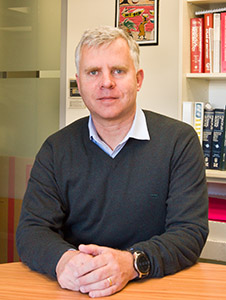Friday 7 August 2020 10:56am

Professor Philip Hill.
An initial test of the University of Otago’s contact tracing system for COVID-19 has produced promising results after most contacts identified in the emergency exercise scenario of a visiting international professor to the Dunedin campus were able to be tracked down.
Chair of the University’s infectious disease emergency planning group, Professor Philip Hill, explains that being a multi-campus university with 20,000 students and about 4000 staff, it is imperative to have an effective and efficient contact tracing system.
The University of Otago has established a contact tracing system centralised on tracking individuals using its high capability wireless network, augmented by other data available through its information technology systems.
“We decided to carry out this test because it is one thing to set up an information system, but another for it to be proven to be fit for purpose, which is to provide the right information over the right time frame,” Professor Hill explains.
“With COVID-19 your systems have to perform at the right level of quality under time pressure to be useful. We wanted to see if our system is as good as we think it is and we also wanted to let others around the country benefit from seeing what we are doing and decide if their systems might benefit from such an evaluation.”
Staff involved in running the contact tracing system were not given details of the scenario beforehand. The emergency exercise scenario of a visiting professor on the Dunedin campus for one day was put to them after the professor reportedly developed COVID-19 symptoms the day following her visit and received a positive test the next day.
The University’s contact tracing team tracked the professor’s actions on campus which included a lecture to students, lunch in the staff club, a tour of a PC3 research laboratory and meeting with the Vice-Chancellor in the Clocktower.
Overall, the contact tracing system identified more than 400 contacts of the imaginary visitor within less than six hours. In total 86 per cent of contacts were able to be contacted by telephone within 24 hours.
Professor Hill says the test identified learnings for the next test of the system and there were limitations, the main one being that at COVID Level One there is no requirement for people on campus to have wireless devices connected as part of contact tracing.
“The main result was that we were able to identify a large number of contacts and it looks like we identified true contacts and also identified those who could have been a contact, but were not; we were able to link them up with their contact details and prove we could contact over 85 per cent of them within 24 hours.”
The University worked together with Southern District Health Board and local Medical Officer of Health, Dr Susan Jack, is complimentary of the exercise carried out.
“From the DHB’s point of view it is important that such a big institution like the University of Otago has an efficient system in place to assist the public health unit with contact tracing.
“We were pleased to be part of and are very supportive of the University doing this scenario testing and are happy with the outcome and learnings.”
For further information, contact:
Professor Philip Hill
Chair, University of Otago’s infectious disease emergency planning group
Email Philip.hill@otago.ac.nz
Liane Topham-Kindley
Senior Communications Adviser
Tel +64 3 479 9065
Mob +64 21 279 9065
Email liane.topham-kindley@otago.ac.nz
